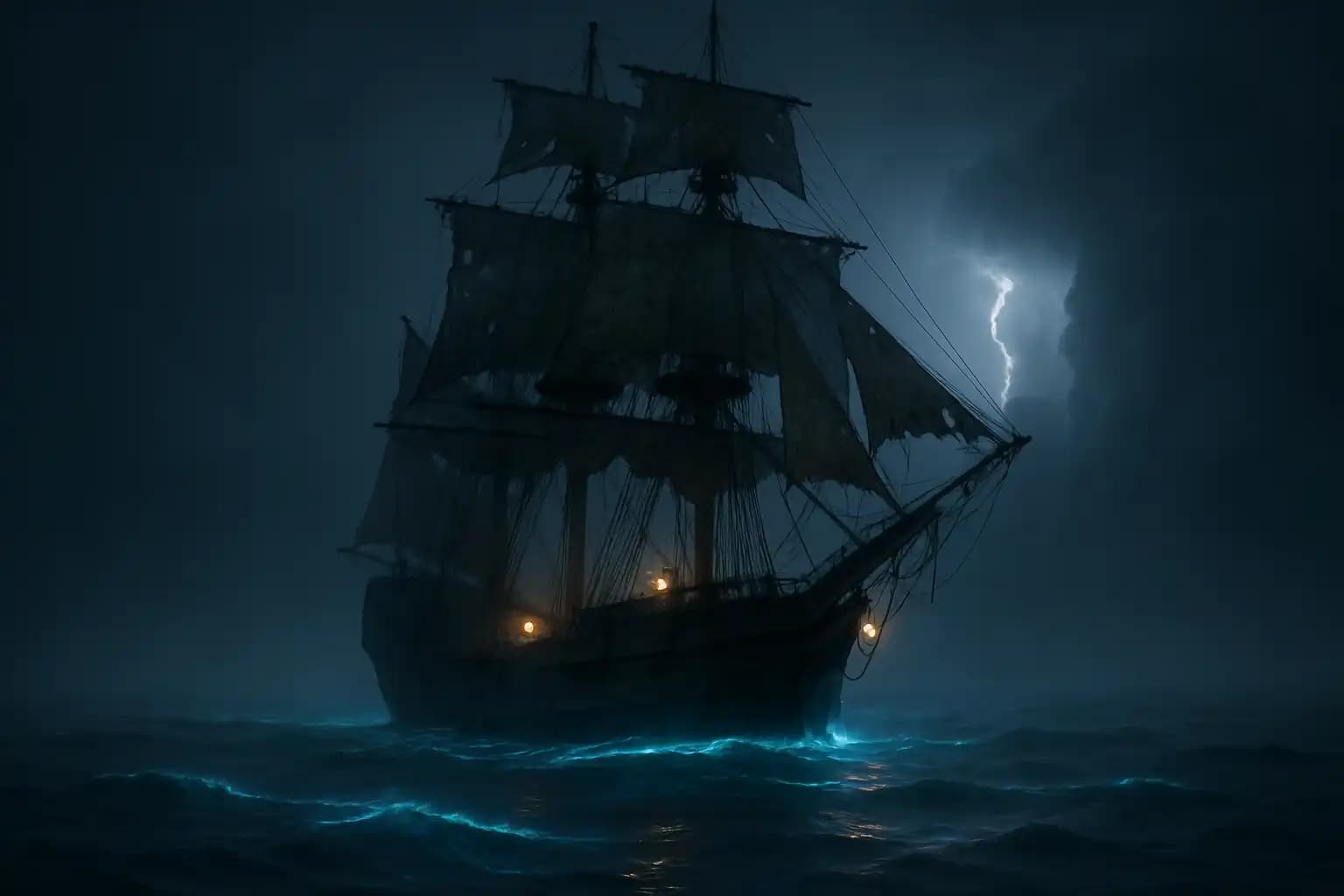1. Drifting Testaments to the Impossible
The ocean loves secrets, but ghost ships flaunt them. Imagine spotting a brigantine under full sail, canvas snapping in a fresh breeze—yet nobody stands at the wheel, nobody coils the ropes, and a meal congeals half-eaten on the galley table. Eyewitness reports date back centuries and defy neat explanations. Search parties board, find everything in order, then scratch their heads while gulls circle above. The pattern repeats often enough that maritime lore files these cases under one unsettling label: unexplained disappearances.
2. Mary Celeste: The Archetype of Absence
The list of spectral vessels starts with the Mary Celeste, found adrift in 1872 with her lifeboat missing and cargo intact. Abandoned barrels of industrial alcohol coated the hold in fumes, suggesting theories of poisoning or spontaneous explosion. Yet the ship’s log held no mayday, no hint of madness. Over a century later, scholars debate whether rogue waves, pirates, or human paranoia sent captain and crew into the yawning Atlantic. According to a comprehensive dossier on public record, every hypothesis remains circumstantial, ensuring the brig remains a benchmark for nautical mystery.
3. Carroll A. Deering: A Schooner Turns into a Warning Sign
On New Year’s Day 1921, coastguardsmen spotted the American five-master Carroll A. Deering aground at North Carolina’s Diamond Shoals. The crew vanished, personal effects untouched, and the galley stew still warm. Investigators considered mutiny, hurricane, and Communist sabotage—the Red Scare was in full roar—but couldn’t pin anything down. Today, conspiracy circles loop the Deering into discussions of magnetic anomalies, citing research like the pulse charts archived in this ongoing study. The premise suggests that shifts in Earth’s field can scramble instruments and disorient sailors until terror overrides training.
4. Ourang Medan: Horror Frozen in Rigor Mortis
If emptiness unnerves you, picture a deck littered with corpses. In 1947, radio operators logged a chilling distress call from the Dutch freighter Ourang Medan: “All officers including captain dead… I die.” When rescuers arrived, they found the entire crew sprawled in grotesque poses, eyes wide, mouths contorted in silent screams. Minutes after boarding, a mysterious explosion forced the salvage team to flee as the ship sank, erasing forensic evidence. Because official registries never confirmed the vessel’s ownership, skeptics cry hoax. Yet similar voice snippets linger in wartime archives and shadowy shortwave recordings cataloged through open audio hunts. Until someone raises the wreck, terror remains the sole certainty.
5. Kaz II: Modern Mystery on Calm Australian Seas
Fast-forward to 2007. The Kaz II, a 12-meter catamaran sailing off Australia, was found motoring in circles. Three experienced yachtsmen were gone; lunch sat on the table, and a GPS ran. Weather was clear, currents gentle. Authorities proposed they fell overboard while fixing a snagged line, but seasoned skippers scoffed. CCTV from the marina departure shows no panic and no foul play. Amateur detectives sift tracking data posted on sailing forums and maritime FOIA drops, still searching for that missing frame where reality blinked.
6. When Ships Sail Into Deserts
Ghost ships don’t only drift on water. Southwestern folklore speaks of a Spanish galleon marooned in California’s Salton sink or deeper in the Mojave Desert. Prospectors in the late 1800s claimed to spot barnacle-encrusted timbers poking from dunes after torrential floods. Geologists point to prehistoric inland seas, but skeptics argue wooden hulls can’t withstand centuries of sun without trace. To date, no expedition has produced conclusive timber samples, though treasure hunters keep combing dunes marked on maps like those linked via this desert survey. Until lidar or luck uncovers proof, the phantom galleon is a salty mirage haunting dry sand.
7. Physics, Phantoms, or Human Error?
Ghost-ship theories divide into three broad camps.
Natural Phenomena: Rogue waves can roll sailors overboard in seconds; methane eruptions might lower water density and sink vessels without warning. Magnetic anomalies could disrupt navigation, echoing data trends examined through geomagnetic studies. These explanations comfort scientists because they lie within physical law.
Criminal or Human Factors: Insurance fraud, piracy, mutiny, and simple negligence account for some cases. Yet they seldom explain immaculate conditions—why would thieves leave cash, charts, or fresh soup behind?
Paranormal or Extraterrestrial: From temporal rifts to USO (Unidentified Submerged Object) abductions, fringe proposals abound. Enthusiasts link patterns of disappearances to celestial alignments in star catalogs and high-altitude drone footage filed in astronomical bulletins. Proof remains elusive, but the theories underline one sobering point: the ocean hides more volume than all planetary landforms combined, leaving room for phenomena we have yet to catalog.
8. Why Crews Vanish Without a Trace
A critical window decides survival, regardless of the trigger. Maritime safety protocols reveal that overboard victims have roughly ten minutes in cold Atlantic waters before hypothermia degrades motor function. A solo watchkeeper hit by a boom could tumble silently while colleagues sleep. Yet ghost-ship records show intact railings, secured lines, and hatches dogged tight—no sign of a struggle with storm or sail. Investigators suspect cascading micro-events: one sailor disappears, others search in panic, and a final wave wipes the deck clear.
Technology should mitigate these spirals, but AIS transponders, EPIRBs, and satellite phones help only if someone triggers them. In several famous cases, power systems hummed, yet distress beacons stayed dormant, hinting at interruptions too sudden—or entities too alien—to allow a button press.
9. Modern Countermeasures—and Lingering Vulnerabilities
Contemporary captains install motion-activated cameras, smart life vests, and auto-deploy lifeboats. Some retrofit EMP-hardened navigation suites after reading studies on sunstorms like the grid-threat assessments mirrored in risk briefings. Every new fail-safe adds complexity and invites fresh failure modes. A firmware glitch during a lightning strike could lock helm controls, repeating the Kaz II drift.
Meanwhile, shipping lanes creep into polar routes to cut fuel costs, exposing crews to rogue ice and magnetic quirks. Insurance models try to price the unknown, but underwriters confess off-record that premiums cannot capture “acts of sea” when the sea invents new tricks.
10. Lessons for Landlocked Readers
Ghost-ship lore is not just sailor gossip; it challenges assumptions about control. If seasoned crews armed with radar, radios, and emergency drills can vanish, what does that say about the rest of us strapped to fragile systems? Emergency planners studying supply-chain choke points often cite maritime disappearances as cautionary tales: redundancy saves lives, but randomness barges in.
On a philosophical level, these stories retune our awe. Oceans comprise 71 percent of Earth’s surface, yet humanity charts more of Mars than seafloor trenches. Ghost ships sail that ignorance like floating exclamation marks, reminding us that arrogance sinks faster than iron.
11. Where Curiosity Goes From Here
Marine archaeologists petition governments for sonar sweeps over wreck clusters; tech startups launch autonomous submarines with LIDAR and high-definition cameras. One consortium proposes blockchain logging for every bolt turned on deck, hoping immutable records deter tampering and illuminate root causes when ships go silent. Whether these efforts solve the next maritime vanishing or enrich the next generation of legends remains to be seen.
For now, the ocean keeps her counsel—except when she coughs up a barnacle-bleached hull at dawn, sails flapping like unraveling parchment, no voices on board except the ones in your head.
Conclusion: Drift Into the Unknown
From the Mary Celeste to phantom galleons bleaching under desert suns, ghost-ship tales reveal an ironic truth: in the age of satellites and smart beacons, mystery still charts wide waters. The sea absorbs testimony, mangles compasses, and humbles statisticians. Maybe one day a breakthrough—chemical, cosmic, or cryptographic—will close the ledger on every missing crew. Until then, horizon watchers will scan misty swells hoping not to see a ship that sails itself.
If fresh evidence surfaces—an unredacted logbook, a sonar ping from impossible depths—you’ll likely read about it first on Unexplained.co. Keep your life jacket handy; the waves have more stories to tell.




